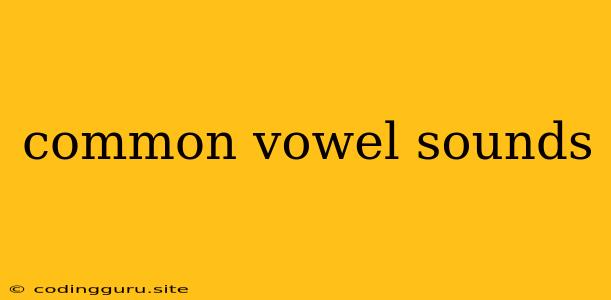Unveiling the Secrets of Common Vowel Sounds
Have you ever wondered how to pronounce words correctly? Mastering the nuances of vowel sounds is crucial for clear and effective communication. While vowels seem simple, they hold a surprising complexity, especially in the English language.
Let's embark on a journey to unravel the secrets of common vowel sounds, understanding their variations and how to produce them accurately.
What are Vowel Sounds?
Vowel sounds are created by the unimpeded flow of air through the mouth, without any obstruction from the tongue or lips. These sounds are fundamental building blocks of language, shaping the overall melody and rhythm of spoken words.
Common Vowel Sounds: A Deep Dive
English has a rich tapestry of vowel sounds, but some stand out as particularly common and fundamental. Let's explore these sounds in detail:
1. The Short Vowel Sounds:
- /ɪ/ (as in "bit", "pin"): This sound is produced with the tongue high and forward in the mouth. Imagine saying "ee" but with a short, quick sound.
- ** /ɛ/ (as in "bet", "pen"):** Similar to /ɪ/, but with the tongue slightly lower and further back. Think of a shorter, more open "eh" sound.
- ** /æ/ (as in "bat", "pan"):** This sound is produced with the tongue low and forward in the mouth. It's similar to the "a" sound in "father" but shorter and more open.
- ** /ʌ/ (as in "but", "sun"):** This sound is made with the tongue slightly lower and more relaxed than the /ɛ/ sound. Imagine a shorter, more "uh" sound.
- ** /ɒ/ (as in "lot", "stop"):** This sound is the most open of the short vowel sounds. The tongue is low and further back in the mouth. It's like a short, quick "ah" sound.
2. The Long Vowel Sounds:
- ** /i:/ (as in "see", "machine"):** This sound is produced with the tongue high and forward in the mouth, similar to /ɪ/, but held longer and with a more sustained "ee" sound.
- ** /ɜ:/ (as in "bird", "first"):** This sound is produced with the tongue slightly lower and further back than the /i:/ sound, with a more "ur" sound.
- ** /ɑ:/ (as in "car", "father"):** This sound is made with the tongue low and back in the mouth, similar to /ɒ/, but held longer and with a more open "ah" sound.
- ** /u:/ (as in "food", "flute"):** This sound is created with the lips rounded and the tongue high and back in the mouth. Think of a sustained "oo" sound.
3. The Diphthongs:
Diphthongs are sounds that involve a glide from one vowel sound to another within a single syllable. Here are some common examples:
- ** /eɪ/ (as in "say", "play"):** This sound starts with a similar position to /ɛ/ and glides towards /i:/
- ** /aɪ/ (as in "buy", "pie"):** This diphthong starts like the /æ/ sound and glides toward /ɪ/.
- ** /ɔɪ/ (as in "boy", "joy"):** This sound starts with a position similar to /ɒ/ and glides toward /ɪ/.
Tips for Mastering Common Vowel Sounds
- Listen attentively: Pay close attention to how native speakers pronounce words. Try imitating their sounds carefully.
- Practice with mirrors: Observing your tongue and mouth movements can help you identify and correct any mispronunciations.
- Record yourself: Listening back to your own speech can provide valuable insights into your vowel sound production.
- Seek feedback: Don't be afraid to ask a friend, teacher, or language tutor for their honest feedback on your pronunciation.
Examples: Putting It All Together
Let's practice identifying and producing common vowel sounds in words:
- bit (/ɪ/) - Notice the short, quick "ee" sound.
- bet (/ɛ/) - The tongue is slightly lower and further back, giving a shorter "eh" sound.
- bat (/æ/) - The tongue is low and forward, producing a short, open "a" sound.
- but (/ʌ/) - The tongue is relaxed and slightly lower than the /ɛ/ sound, resulting in a short "uh" sound.
- lot (/ɒ/) - The tongue is low and back, producing a short, open "ah" sound.
- see (/i:/) - This is a longer, sustained "ee" sound.
- bird (/ɜ:/) - Notice the slightly lower, further back "ur" sound.
- car (/ɑ:/) - The tongue is low and back, producing a long, open "ah" sound.
- food (/u:/) - This is a sustained "oo" sound with rounded lips.
- say (/eɪ/) - The sound starts with a position similar to /ɛ/ and glides toward /i:/
- buy (/aɪ/) - This diphthong starts like the /æ/ sound and glides toward /ɪ/.
- boy (/ɔɪ/) - This sound starts with a position similar to /ɒ/ and glides toward /ɪ/.
Conclusion
Mastering common vowel sounds is a vital step in achieving fluent and clear pronunciation. By focusing on understanding the nuances of these sounds, practicing regularly, and seeking feedback, you can enhance your communication skills and confidently express yourself with precision. Remember, the key is to pay attention, practice diligently, and be patient with your learning process.
